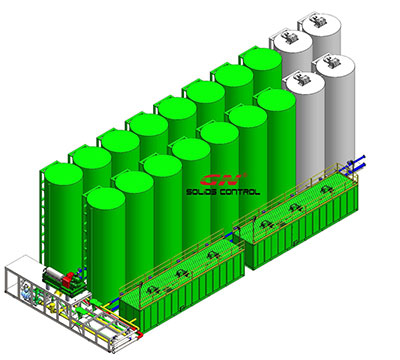Liquid mud plant is a supporting base for oil and gas drilling rigs. Normally, a liquid mud plant will service some oil rigs nearby. It is essential to keep the liquid mud plant fluently and smoothly. Once there is a urgent request from drilling rigs, liquid mud plant should mix and offer qualified drilling fluids immediately.
Liquid mud plant is mostly used to make oil base mud. Diesel oil is widely stocked and used here as base oil. It has pollution to the environment. Government has strict rules and prohibits any oil leakage to environment.
So there will be a dam around the liquid mud plant to prevent any leakage come out of the liquid mud plant base. In normal conditions, it is ok. But when there is a raining, things will be difficult. As the government has rules, the raining water in the initial 15 minutes within the dam should be treated.
But there is so many difficult to realise it: it is difficult to control the time. which equipment should be used? And should it be processed? The liquid mud plant need to use huge quality of pure water to make qualified drilling mud. Even for the oil based mud, they need to use pure water. It should be a good idea to reuse the rain water for mud mixing. If the rain water can be used to make oil based mud, it will be a big save. The liquid mud plant can save cost on rain water treatment, as well as water for mud mixing.
Another big cost is the storage of old drilling fluids. After some circulation, the drilling fluids will be not qualified for drilling, as there are too much ultra fine solids inside, the mud is weighted. Decanter centrifuge is very important at this stage, It can remove the fine solids inside the old drilling fluids and make it qualified to drilling rigs. The quality of liquid mud plant depends on the mud storage capacity of each liquid mud plant. It the old mud can be treated on time after arrive the plant site, they can save cost on old mud storage.

I have read your article carefully and I agree with you very much. This has provided a great help for my thesis writing, and I will seriously improve it. However, I don’t know much about a certain place. Can you help me?
TornadoCash: ваша шлюз к анонимным транзакциям на Ethereum. Сохраните свои финансовые операции в тайне с помощью этого децентрализованного миксера.
Discover the power of privacy with TornadoCash! Learn how this decentralized mixer ensures your transactions remain confidential.
mexican pharmaceuticals online: cmqpharma.com – п»їbest mexican online pharmacies
Very interesting info!Perfect just what I was looking for!Raise blog range
https://indiapharmast.com/# buy medicines online in india
pharmacy website india: indian pharmacy online – reputable indian pharmacies
п»їbest mexican online pharmacies: buying from online mexican pharmacy – mexican drugstore online
https://indiapharmast.com/# best india pharmacy
best india pharmacy: indian pharmacies safe – online shopping pharmacy india
mexican pharmacy: mexico pharmacies prescription drugs – mexico pharmacy
mexican online pharmacies prescription drugs: pharmacies in mexico that ship to usa – buying prescription drugs in mexico online
pharmacy canadian superstore: canada drug pharmacy – canada pharmacy world
http://indiapharmast.com/# online pharmacy india
online pharmacy india: top online pharmacy india – п»їlegitimate online pharmacies india
top 10 online pharmacy in india: indian pharmacy paypal – indian pharmacies safe
canadian online drugs canadian pharmacy 365 best canadian online pharmacy
canadian pharmacy 24h com: legit canadian pharmacy – canadian pharmacy sarasota
canadian pharmacy drugs online: certified canadian pharmacy – escrow pharmacy canada
cheap clomid for sale: how to buy generic clomid without prescription – order clomid pills
http://ciprodelivery.pro/# cipro
http://paxloviddelivery.pro/# Paxlovid buy online
paxlovid price: paxlovid generic – paxlovid buy
https://doxycyclinedelivery.pro/# where to get doxycycline in singapore
http://amoxildelivery.pro/# buy amoxicillin 500mg capsules uk
where to buy cipro online: buy cipro without rx – buy cipro cheap
http://amoxildelivery.pro/# buy amoxicillin online without prescription
paxlovid pill: Paxlovid buy online – paxlovid cost without insurance
http://ciprodelivery.pro/# cipro online no prescription in the usa
http://paxloviddelivery.pro/# Paxlovid buy online
п»їcipro generic: buy ciprofloxacin over the counter – ciprofloxacin over the counter
http://amoxildelivery.pro/# amoxicillin 500mg over the counter
where buy clomid for sale: where can i buy cheap clomid no prescription – can i get generic clomid no prescription
http://clomiddelivery.pro/# can i get clomid
amoxicillin 875 125 mg tab: canadian pharmacy amoxicillin – generic amoxicillin over the counter
can we buy amoxcillin 500mg on ebay without prescription: buy amoxicillin 500mg capsules uk – amoxicillin medicine over the counter
get generic clomid no prescription: can you buy cheap clomid without dr prescription – where can i get cheap clomid pill
buy amoxicillin online without prescription: buy amoxicillin 500mg canada – amoxicillin 1000 mg capsule